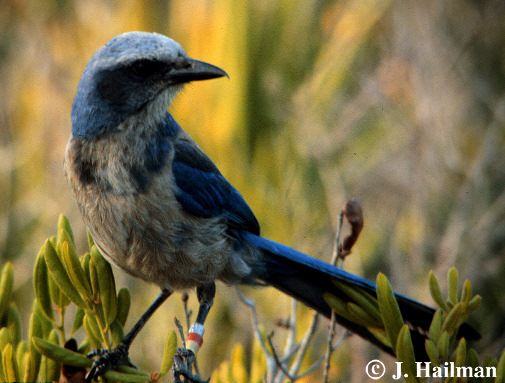The following is from:
Dr. T. Luke George
Ornithology
Lecture Notes
Why do birds breed cooperatively?
Cooperative breeding poses an enigma for evolutionary biologists because
helpers are apparently behaving altruistically. Closer
examination of cooperative breeding systems, however, has shown that
helpers are actually acting in their own self interest.
Analysis of Fitness Trade-offs of Cooperative Breeding
First we must weigh the costs and benefits of helping to the breeders
and the helpers to determine if helpers are suffering lower
fitness as a consequence of helping.
For example:
The Florida Scrub Jay (Aephelacoma caerulescens) is a
subspecies of the Scrub Jay. It inhabits scrub oak woodlands in central
Florida. A population has been under intensive study for nearly two decades
by Glen Woolfenden and John Fitzpatrick.
This population is sedentary; individuals are long-lived; and long-term
monogamy is the rule as a mating system. Groups are permanent residents
on large, all-purpose territories.
Approximately 1/2 of the breeding pairs are accompanied by helpers;
pairs have as many as 6 helpers that remain with them for 1-5 years; most
helpers are offspring of one or both of the breeders.
Helpers assist breeders in the following ways. Helpers:
-
Feed young (food contributions vary with age & sex - older helpers
feed more than younger helpers and males feed more than females).
-
Defend territory boundaries.
-
Dissuade predators.
The evaluation of fitness benefits to helpers and breeders is
crucial. Woolfenden and Fitzpatrick evaluated the question of whether
or not helpers really help (increase reproductive success of breeders)
in the following manner.
-
Benefit to Breeders:
-
Pairs without helpers raise - 1.62 young/nest
-
Pairs with helpers raise - 2.20 young/nest
So, we conclude that pairs are benefitted by helping. There are costs,
however.
-
Benefit to Helpers - Woolfenden and Fitzpatrick assessed the fitness payoff
(Reproductive Success [RS] = # offspring produced) of helping vs. the fitness
payoff of breeding as a novice.
-
RS of pairs with no helpers - 1.62 young/nest
-
RS of pairs with 1 helper - 1.94 young/nest
Therefore, helper success = 1.94 - 1.62 = 0.32. But, this must be
devalued by 0.5 because individuals only share 1/2 their genes with the
siblings that they are helping to raise. Thus, 0.32(0.5) = 0.16
In a few cases, young birds are successful in establishing themselves
as breeders. These novice breeders produce 1.03 young/nest. Again, we must
devalue this because an individual shares only 1/2 of its offsprings genes.
Thus, 1.03(0.5) = 0.51
Conclusion: Florida Scrub Jays would do better (fitness) breeding
as novices than helping to raise kin. Other studies generally reveal similar
results, i.e., helpers do help but they would do better to breed on their
own.
So, why don't they breed on their own? There are other benefits
to staying home and helping including:
-
Survival is higher for individuals that remain on their natal territory.
-
The survival of the helpers parents and kin are enhanced thereby enhancing
their inclusive fitness.
-
Male helpers enhance their chances of obtaining their natal territory or
budding off a new territory by remaining on their natal territory
Thus, in terms of lifetime fitness, young Florida Scrub Jays do better
by staying and helping. The most important factor in this 'decision' appears
to be 'ecological constraints' (see below; the probability of a young scrub
jay establishing a territory is low).
Evolution of Cooperative Breeding
The ultimate explanations for cooperative breeding systems (why has
it evolved?) fall into three general arguments:
-
Kin Selection ("Choice"):
-
Individuals help because of indirect fitness benefits derived from helping
raise related individuals.
-
There is support for this explanation in most examples: Individuals do
help and the offspring raised are close kin, either sibs or 1/2 sibs. But,
as indicated in the Scrub Jay example, individuals would appear to do better
by breeding on their own.
-
Ecological Constraints ("Forced Choice"):
-
Individuals help because they are forced to owing to limited success in
breeding on their own.
-
There is evidence for this explanation in the following:
-
Many species that breed cooperatively do so in habitats that are limited.
The habitat is saturated by individuals and neighboring habitat is suboptimal.
Thus, there are few available breeding opportunities. The habitat limitation
makes helping a profitable reproductive option because:
-
Dispersal risk is high.
-
Probability of territory establishment is low.
-
Probability of obtaining a mate is low.
-
Probability of breeding is low.
-
Reciprocity- Helpers benefit through reciprocity with offspring they raise.
In many cooperative breeding systems, birds must move as a group to obtain
breeding vacancies. By helping to raise more offspring, helpers enhance
their chances of obtaining a breeding territory.
Back
to BIO 554/754 - Avian Mating Systems

